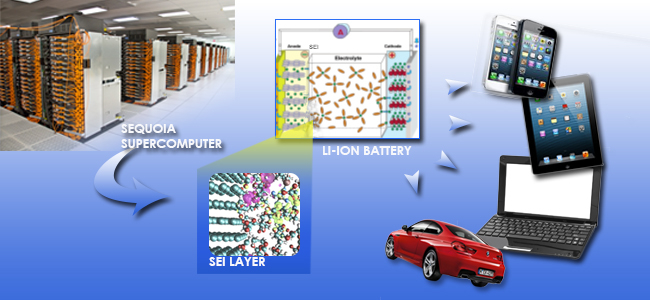LLNL leads new initiative to improve lithium-ion batteries
Working with Lawrence Berkeley National Laboratory (LBNL), the scientists are developing a new methodology for performing first-principles quantum molecular dynamics (QMD) simulations at an unprecedented scale to understand key aspects of the chemistry and dynamics in lithium-ion (Li-ion) batteries, particularly at interfaces.
Li-ion batteries have revolutionized personal electronics and have the potential to do the same for transportation and electrical distribution. In transportation in particular, a significant advance in battery performance and lifetime will allow the transition from current gasoline- and diesel-based vehicles to plug-in hybrids and all-electrics with comparable or better power, range and cost. This, in turn, would greatly reduce the nation's dependence on fossil fuels and carbon emissions associated with them. An advance in safety will have significant implications for aviation as well, as the grounding of Boeing 787s worldwide due to Li-ion battery fires has made all too clear.
However, progress in improving the performance, lifetime, and safety of Li-ion batteries has been hindered by an incomplete understanding of the basic chemistry and dynamics.
Using Sequoia, the second fastest supercomputer in the world, housed at LLNL, and other supercomputers at LLNL and LBNL, the team will combine current state-of-the-art quantum mechanical methods and new methodology being developed to reach the length and time scales required to capture the essential dynamics of these complex, multiphase Li-ion systems.
"In so doing, we aim to achieve a breakthrough in the understanding of these ubiquitous electrochemical systems, and thereby pave the way for fundamental advances in these central technologies," said lead scientist John Pask of the Condensed Matter and Materials Division (CMMD) at LLNL.
Many limitations of current Li-ion technologies center on the formation and evolution of the solid-electrolyte interphase (SEI) layer between anode and electrolyte, a product of electrolyte decomposition. Particularly, long-term reliability is affected as the flow of Li+ into and out of the anode is impeded during the charging cycle, and also the electrical characteristics of the battery degrade as the SEI layer forms.
However, the SEI layer is critical for performance, since it helps prevent further decomposition of the electrolyte at the anode interface. In practice, a thin, stable SEI layer with high Li+ ion conductivity and low electrical conductivity is required. Any dynamic build-up or modification of the SEI film during operation must be avoided. "A sudden change/malfunction of the SEI layer could be a significant safety concern," Pask said.
To date, there has not been a comprehensive theoretical understanding of the details of SEI layer formation and evolution, which has hindered progress in the design of optimal electrolyte/anode systems.
To understand these processes, the team is undertaking QMD simulations of an extensive series of systems, beginning with bulk pure-electrolyte systems, proceeding to mixed electrolytes with various salts, and finally to complete liquid-on-anode simulations.
The initial simulations, requiring configurations of up to 1,000 atoms, are being carried out using the massively parallel Qbox planewave code at LLNL. Larger simulations, requiring 10,000 atoms or more, will be carried out using the new Discontinuous Galerkin (DG) methodology being developed. "It is only with the advent of computational resources on the scale now available and breakthrough new quantum mechanical and numerical methods which can effectively harness them, that this research is now possible," said Pask.
The team, which includes LLNL scientists Vincenzo Lordi, Erik Draeger, and Mitchell Ong, and LBNL scientists Chao Yang and Lin Lin, recently received a five-year $3.7 million grant to carry out the research from DOE Basic Energy Sciences (BES) and Advanced Scientific Computing Research (ASCR) programs, through the Scientific Discovery through Advanced Computing (SciDAC) program.
Contact
Anne M Stark[email protected]
925-422-9799
Tags
BatteriesPhysical and Life Sciences
Energy
Featured Articles








